Brewing Beer with Black Malt
Published: July 29, 2025 at 7:37:07 AM UTC
Last updated: December 9, 2025 at 7:40:49 PM UTC
Brewing beer is an art that demands a profound grasp of its components and their interactions. Sharp roast malts such as Black Malt, in particular, can significantly enhance a beer's flavor profile. They are known for adding bitter notes, reminiscent of burnt toast, and acrid flavors.
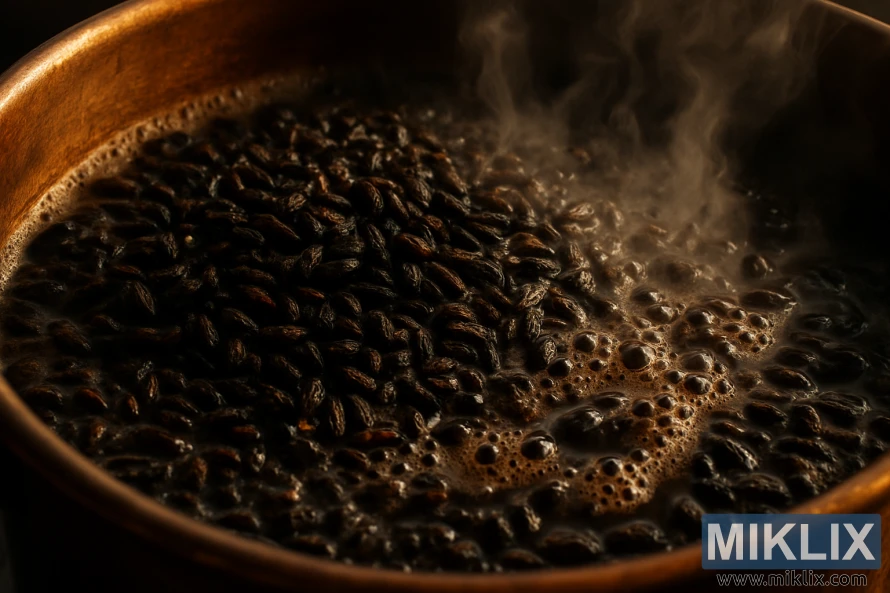
Key Takeaways
- Understanding the characteristics of sharp roast malts is essential for brewing.
- Black malt can impart a range of flavors, from bitter to acrid.
- Mastering the use of black malt can elevate the flavor profile of beer.
- Brewing with black malt requires a deep understanding of its interactions with other ingredients.
- The art of brewing with black malt can result in complex and nuanced beer flavors.
Understanding Black Malt: Essential Characteristics
For brewers aiming to craft complex beers, grasping black malt's characteristics is key. It's renowned for its intense flavor and aroma, significantly shaping the beer's final taste.
Black malt's flavor profile is marked by sharp roast and bitter notes. It also brings flavors of burnt toast and acrid undertones. These traits make it invaluable for adding depth and complexity to beers.
The aroma of black malt is equally distinctive, featuring a deep, roasted scent. This scent enhances the beer's overall sensory experience. It stems from the malting process, where malt is roasted to various levels to achieve the desired flavor and color.
Mosher notes that malts in the 70–200 °L color range, including black malt, are considered “harsh zone” malts. This classification highlights black malt's role in adding a robust, intense character to beers.
Breweries employ black malt in various beer styles to achieve specific flavor profiles. Its use can range from adding a subtle roasted note to dominating the flavor.
The Manufacturing Process of Black Malt
Creating black malt involves a detailed process that shapes its taste and aroma. The journey includes malting, kilning, and roasting. Each step is vital for achieving the unique flavor and color of black malt.
Malting starts with soaking grains in water to activate enzymes. This is followed by germination, which converts starches into fermentable sugars. The grains are then dried in a kiln or with hot air to halt germination.
Kilning and roasting are essential for black malt's dark color and distinct taste. The temperature and duration of these steps influence the final product. Higher temperatures lead to a darker, more intense malt.
Contrary to its reputation, black malt is not inherently astringent. This makes it a great choice for stouts and porters, where a deep color is desired.
Impact on Beer Color and Appearance
The inclusion of black malt in brewing profoundly affects a beer's color and appearance. Known for its ability to darken beer, black malt is a key component in many darker beer styles. This characteristic is a hallmark of these styles.
Roast malts, including black malt, are essential in darker beer styles. These include English and American browns, porters, and stouts, as well as black IPAs and continental dark beers like Bock. The amount of black malt used can vary, leading to colors ranging from deep reds and browns to almost black. The specific brewing techniques also play a role in the final color.
When crafting a beer recipe, brewers must thoughtfully consider the effect of black malt. The ratio of black malt to other ingredients and the brewing techniques used are critical. These factors significantly influence the beer's color and appearance.
- Deep, dark colors characteristic of darker beer styles
- Variations in color depending on the quantity of black malt used
- Impact on beer's appearance due to brewing techniques
By adjusting the amount of black malt and employing various brewing techniques, brewers can achieve a wide range of colors and appearances. This makes black malt a versatile ingredient in the brewing process.
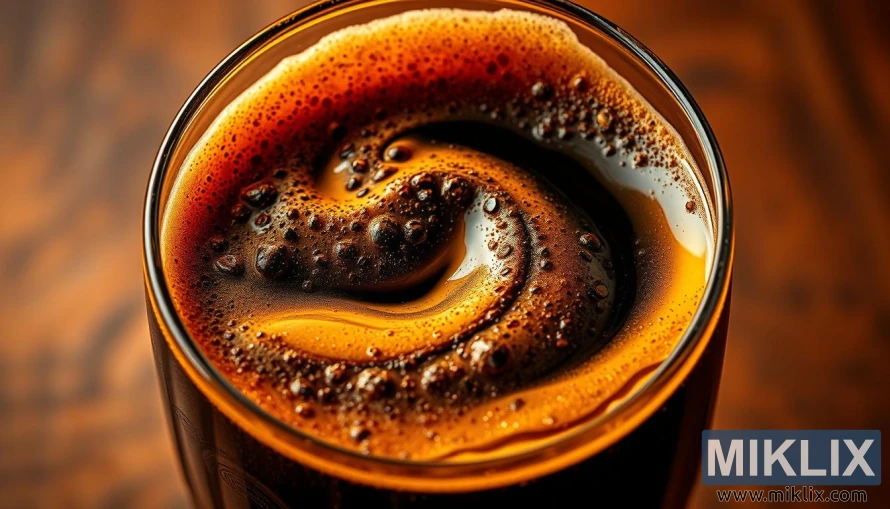
Flavor Contributions of Black Malt
In the world of brewing, black malt is a key player in adding depth and complexity. It introduces a variety of flavors, such as dried fruit, plum, and chocolate, when used in moderation. These flavors also include mocha, coffee, toasted marshmallow, and caramel notes.
Yet, overusing black malt can lead to unwanted flavors. These include burnt toast, burnt marshmallow, and harsh tannic notes. The secret to using black malt effectively is to balance its sharp, bitter, and acrid flavors with other ingredients.
The flavor profile of black malt is complex and can greatly influence a beer's character. By understanding how to use black malt effectively, brewers can craft unique and captivating beer styles. These styles can stand out in the market.
- Sharp flavors add a distinct edge to the beer's taste.
- Bitter flavors contribute to a balanced bitterness.
- Acrid flavors can introduce a dry, astringent sensation.
Mastering the use of black malt allows brewers to enhance their beers' flavor profiles. This results in complex and engaging brews that appeal to a wide range of palates.
Common Beer Styles Using Black Malt
Black malt is a key ingredient in several popular beer styles, known for their dark color and robust flavors. It significantly contributes to the taste and appearance of these beers.
Stouts and porters are the most common styles using black malt. Stouts have a dark color and flavors that range from coffee to chocolate. Porters, on the other hand, have a more complex flavor profile with roasted malt notes. Black malt enhances the roasted flavors and achieves the desired color in these styles.
Black IPAs also rely heavily on black malt. This style combines the hoppiness of an IPA with the dark color of black malt. The use of black malt in black IPAs adds depth without overpowering the hop flavors. Other styles that may use black malt include robust porters, imperial stouts, and some Belgian ales.
The choice of black malt type can vary based on the desired flavor profile. Brewers might choose black patent malt for a smoother finish or other types like pale chocolate or carafa malts for a sharper edge. Black malt's versatility makes it a valuable ingredient in a brewer's toolkit.
- Stouts: Known for dark color and coffee or chocolate flavors.
- Porters: Complex flavor profiles with roasted malt notes.
- Black IPAs: Combines hoppiness with dark color.
In conclusion, black malt is essential in brewing various dark beer styles. Its ability to impart a range of roasted flavors and colors makes it indispensable for brewers aiming to create beers with distinct characteristics.
Proper Storage and Handling Techniques
To preserve the distinct characteristics of black malt, brewers must adhere to specific storage and handling practices. Black malt, known for its robust flavor and dark color, can be sensitive to environmental conditions. Proper storage is key to maintaining its quality and freshness.
When storing black malt, it's essential to keep it in a cool, dry place. Moisture can cause the malt to become stale or develop off-flavors. Use airtight containers to protect the malt from air and moisture. The storage area should be away from direct sunlight and heat sources.
Handling black malt requires care to prevent damage. Avoid dropping or crushing the malt, as this can lead to loss of flavor and aroma. When milling or crushing the malt, ensure the equipment is clean and dry to prevent contamination.
- Store black malt in a cool, dry environment.
- Use airtight containers to maintain freshness.
- Handle the malt gently to prevent damage.
By following these storage and handling techniques, brewers can ensure their black malt remains in optimal condition. This is ready to contribute its unique characteristics to their brews.
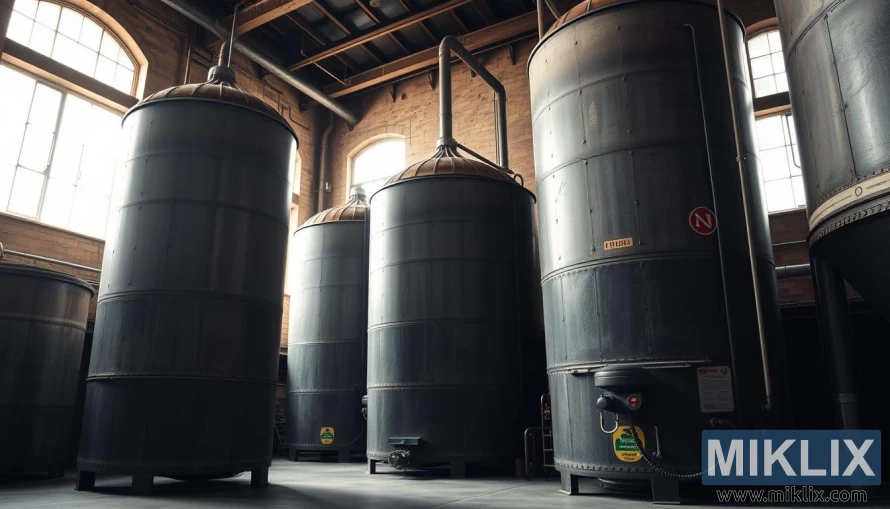
Calculating Black Malt Quantities in Recipes
Calculating black malt quantities is a critical step in recipe formulation for brewers. The amount of black malt used can significantly impact the flavor and appearance of the final beer.
To determine the correct quantity, brewers should consider the style of beer they are brewing and the desired level of roastiness. A general guideline is to use between 1% to 5% of the total grain bill for black malt.
- Start with a small percentage and adjust to taste.
- Consider the type of black malt being used, as different types can have varying levels of roastiness.
- Be mindful of the overall grain bill and how the black malt will interact with other ingredients.
By following these guidelines and tips, brewers can effectively calculate the right amount of black malt for their recipes. This ensures the desired flavor and appearance in their beer.
Mashing Techniques for Black Malt
The art of mashing with black malt requires a deep understanding of temperature, pH, and water quality. These elements are key to the final flavor and aroma of the beer.
To achieve the best results, brewers must carefully control the mashing process. Here are some key considerations:
- Temperature: The optimal temperature for mashing with black malt is between 152°F and 158°F (66°C to 70°C). This range helps activate enzymes and extract the desired compounds.
- pH: Maintaining the right pH level is critical. A pH range of 5.2 to 5.6 is generally considered optimal for mashing with black malt.
- Water Quality: The quality of the water used in mashing can significantly affect the beer's flavor. Brewers should use water that is free from contaminants and has the appropriate mineral profile.
By mastering these mashing techniques, brewers can unlock the full flavor of black malt. This leads to the creation of complex, flavorful beers. The following list outlines the benefits of proper mashing techniques:
- Enhanced flavor extraction
- Improved beer clarity
- Better control over the final product's characteristics
In conclusion, mashing techniques for black malt require attention to detail and a thorough understanding of the factors that influence the brewing process. By controlling temperature, pH, and water quality, brewers can produce high-quality beers that showcase the unique characteristics of black malt.
Alternative Uses in Brewing
Beyond its traditional uses, black malt opens up a world of possibilities for brewers. It's not just for stouts and porters. Black malt can add depth and complexity to many beer styles.
One exciting use for black malt is in specialty beers. Brewers can add a roasted flavor to IPAs or pale ales. This creates a fascinating contrast between hoppy and roasted notes. It can also enhance the flavor profile of sour beers.
Experimental brews are another area where black malt excels. By using it in unconventional recipes, brewers can innovate. For example, adding black malt to Belgian-style ales or wheat beers can create unique flavors.
Some brewers also experiment with black malt in different brewing stages. Adding it late in fermentation or for dry-hopping can introduce interesting flavors and aromas.
- Using black malt to create a coffee stout with deep, roasted flavors.
- Incorporating black malt into a smoked beer for added complexity.
- Experimenting with black malt in a fruit beer to balance out the sweetness of the fruit.
By exploring these alternative uses, brewers can unlock new possibilities. They can create beers that are truly unique and stand out from the crowd.
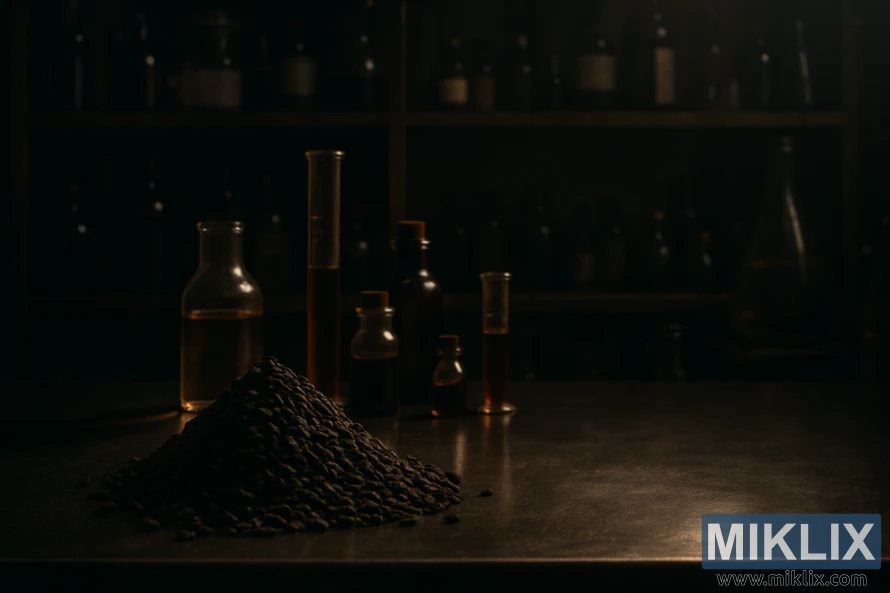
Combining Black Malt with Other Grains
To achieve a rich, roasted flavor in beer, brewers often combine black malt with grains like wheat, rye, and oats. This combination can significantly enhance the beer's flavor profile and complexity.
Combining black malt with other grains can add depth and a roasted flavor to beers. For instance, pairing black malt with wheat can create a balanced flavor. The wheat contributes a lighter, crisper character that complements the dark, roasted notes of the black malt.
- Wheat and Black Malt: Wheat adds a refreshing quality to beer, which can offset the bitter, acrid taste of black malt. This combination is ideal for brewing styles that require a balance between dark flavors and a crisp finish.
- Rye and Black Malt: Rye contributes a spicy flavor that can enhance the complexity of beers brewed with black malt. The combination is particular suited to styles like Rye Porter or Black Rye IPA.
- Oats and Black Malt: Oats can add a smooth, velvety texture to beers, which complements the sharp roast of black malt. This combination is beneficial for brewing styles like Oatmeal Stout.
When combining black malt with other grains, it's essential to consider the proportions of each grain to achieve the desired flavor. Generally, black malt is used in smaller quantities due to its potent flavor.
In conclusion, combining black malt with grains like wheat, rye, and oats offers brewers a wide range of possibilities for creating complex, flavorful beers. By understanding the characteristics of each grain and how they interact with black malt, brewers can craft unique beer styles.
Troubleshooting Common Issues
When brewing with black malt, brewers may encounter several common issues. These can be addressed with the right troubleshooting techniques. Black malt, known for its intense flavor and color contributions, can sometimes lead to off-flavors, poor head retention, and inconsistent color in the final product.
One of the most common issues brewers face when using black malt is the development of off-flavors. These can range from burnt or acrid tastes to unpleasantly sharp or bitter notes. The cause of these off-flavors can often be traced back to the quantity of black malt used or the mashing techniques employed.
- Using too much black malt can overpower the beer, leading to undesirable flavors.
- Inadequate mashing techniques can result in the extraction of unwanted compounds from the black malt.
- Poor quality black malt can also contribute to off-flavors.
Poor head retention is another issue that brewers may encounter when brewing with black malt. This can be due to the high kilning temperatures used in the production of black malt, which can affect the beer's foam stability.
- Adjusting the amount of black malt used can help mitigate its impact on head retention.
- Using ingredients that enhance foam stability, such as certain types of wheat or foam-enhancing additives, can counteract the negative effects of black malt.
- Ensuring proper brewing techniques, such as adequate boiling and cooling, can also help maintain good head retention.
Inconsistent color is a further challenge that brewers may face. The intensity of the color contributed by black malt can vary based on the specific type used, the quantity, and the brewing process.
- Standardizing the brewing process and the quantity of black malt used can help achieve a more consistent color.
- Understanding the specific characteristics of the black malt being used, including its Lovibond rating, can aid in achieving the desired color.
By understanding the causes of these common issues and applying the right troubleshooting techniques, brewers can effectively use black malt. This allows them to create high-quality beers with complex flavors and appealing appearances.
Professional Brewing Tips and Techniques
Mastering black malt is essential for brewers aiming to craft complex, high-quality beers. Professional brewers employ various techniques to achieve the best outcomes with this ingredient.
One critical tip is to use black malt sparingly. It can overwhelm other flavors in your beer. Begin with a small amount and adjust as needed. The type of black malt used also impacts flavor, so consider this when selecting.
When adding black malt to your recipe, balance is key. It not only enhances flavor but also color and body. Experimenting with different mashing techniques can reveal the best in your black malt.
By adopting these professional brewing tips and techniques, you can effectively use black malt to elevate your beers. Whether brewing a stout, porter, or another style, black malt adds value to your grain bill. With dedication and patience, you'll master the desired flavor and character in your brews.
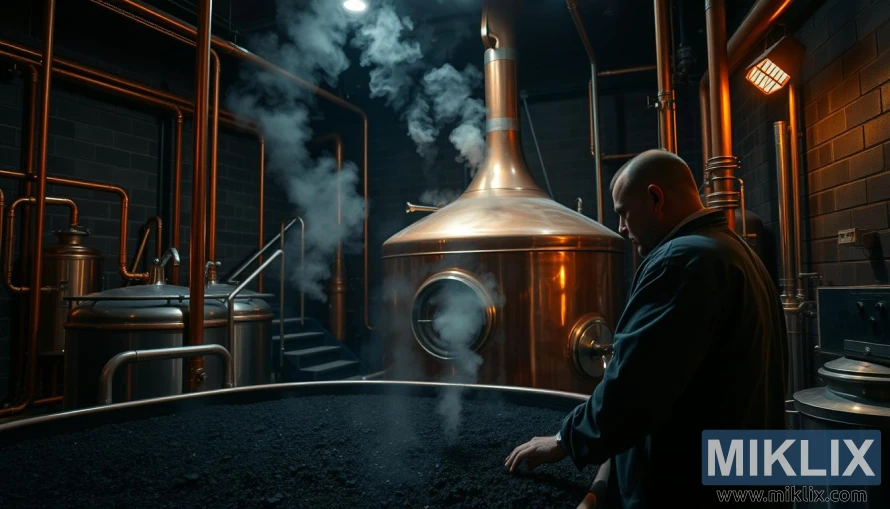
Health and Safety Considerations
When working with black malt in brewing, health and safety are top priorities. Brewers must recognize the hazards of handling black malt. These include dust inhalation and accidents caused by poor sanitation and ventilation.
Proper ventilation is essential in the brewing area. It prevents dust and particles from black malt inhalation. Good airflow reduces the risk of respiratory issues and other health problems.
Sanitation is also critical in brewing. Brewers must keep the environment clean to avoid contamination and spoilage. This involves regular cleaning of equipment and surfaces that touch black malt and other ingredients.
Handling black malt requires caution to prevent accidents. Here are some key considerations:
- Wear protective gear, including masks and gloves, when handling black malt to minimize exposure to dust.
- Store black malt in a dry, well-ventilated area to prevent moisture absorption and reduce the risk of mold growth.
- Ensure that storage containers are tightly sealed to prevent spills and contamination.
By focusing on health and safety, brewers can create a safer environment. This allows them to produce high-quality beers using black malt.
Quality Assessment Methods
Assessing black malt quality requires a blend of sensory evaluation, laboratory testing, and brewing trials. These methods are vital for understanding the characteristics and performance of black malt in brewing.
Sensory evaluation is a key initial step. It involves assessing the black malt's appearance, aroma, and flavor. This process includes checking for visible defects, evaluating the aroma's intensity and quality, and tasting its flavor.
Laboratory testing offers deeper insights into the black malt's properties. It measures moisture content, extractive power, and color intensity. These metrics help brewers predict how the malt will act during brewing.
Brewing trials are also critical. They allow brewers to test the black malt's performance in real brewing scenarios. This involves brewing small batches and evaluating the beer's quality, flavor, and character.
By integrating these quality assessment methods, brewers can guarantee their black malt meets the necessary standards. This leads to improved brewing results.
- Sensory evaluation for appearance, aroma, and flavor
- Laboratory testing for moisture content, extractive power, and color intensity
- Brewing trials to assess performance in actual brewing conditions
Conclusion
Mastering black malt is essential for brewers aiming to craft complex, dark beers with deep flavors. Understanding its characteristics and how to use it effectively in your brewing process can significantly enhance your craft.
This article has covered the key aspects of black malt, its production, and its effects on beer color and taste. By combining this knowledge with proper storage, handling, and mashing techniques, you can fully harness black malt's capabilities in your recipes.
As you continue to experiment with black malt, remember that practice is key. Refine your techniques and don't hesitate to try new combinations to achieve unique flavors. With a solid understanding of black malt's role in brewing, you'll be well on your way to creating exceptional dark beers that highlight its distinctive qualities.
In summary, black malt is a versatile ingredient that can add depth and complexity to various beer styles. By mastering its use, you'll broaden your brewing skills and create beers that are renowned for their rich, roasted flavors.
Further Reading
If you enjoyed this post, you may also like these suggestions:
- Brewing Beer with Brown Malt
- Brewing Beer with Midnight Wheat Malt
- Brewing Beer with Special Roast Malt
